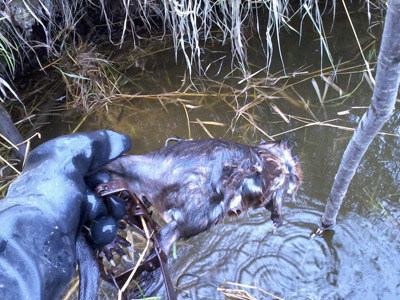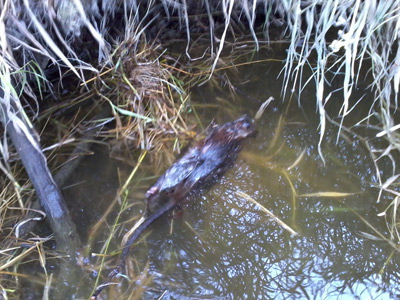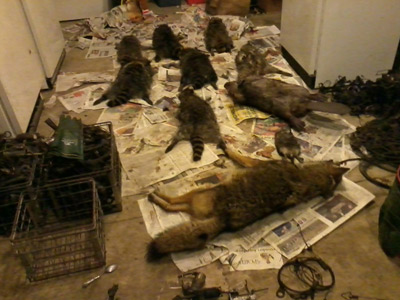ON THE TRAPLINE WITH ARNIE GROEHLER
OPENING WEEK FOR MUSKRAT TRAPPING IN SOUTHERN WISCONSIN: OCT 27TH - NOV 2ND
MORE MUSKRAT TRAPPERS THAN MUSKRATS
My start as a muskrat trapper came in a more round about way from that of most outdoorsmen. As a youth I saw a flyer offering a $5.00 bounty for "chicken hawks" at the county building. This was a lot of money to a rural kid during the 1960's. I researched what a chicken hawk might look like, but could not come up with any scientific information. Still undeterred I rode my bike up to the county seat (35 miles away).
"I plan on becoming a chicken hawk trapper and I need to know what one looks like,” I said to the clerk upon arrival. "Son,” he said, “any hawk you bring in here is a chicken hawk."
This was a time when hawks, owls and raptors in general were not really appreciated or tolerated. All that summer I tried my best, but was not able to catch any "chicken hawks." Seeing my frustration, one of the local farmers recommended that I try catching muskrats instead. He claimed that they were much easier to catch, and more plentiful. So that fall I set out traps for muskrats in a local marsh, and have been trapping them ever since.
At 4:00 am on opening day of the muskrat season I arrived at a favorite marsh. In the distance I could see the beams of several headlamps spreading out into all corners of the marsh. So much for trapping this marsh this year; there were probably just as many trappers as muskrats.

The first muskrat of the season is welcomed aboard
Word of historically high prices for muskrat fur has generated much interest. Everyone was hoping to make a few bucks catching muskrats. I remember back just a few years ago when the price levels were not that high. I often would have entire marshes to myself, as no one really wanted to trap $4.00 muskrats. This year the prices are now over $12.00 (and still climbing) which generates much interest. There are many unemployed outdoorsmen in rural Wisconsin who are looking at muskrats (and other fur bearing animals) to provide some much needed supplemental income. This is a common occurrence; when fur prices are high there are many trappers; when prices drop only those of us considered "hard-core" guys are out there.
WHERE HAVE ALL THE MUSKRATS GONE? TO CHINA, EVERY ONE
Twenty years ago people in China did not know what a muskrat was. Our initial attempts at marketing them did not fare so well, as the word "muskrat" when translated into Mandarin Chinese, came out something like "smelly rat." Who wants a garment made of "smelly rats?"
Once we got past the name hurdle the Chinese started to slowly purchase a few and the market developed. This type of marketing also worked for my grandfather during the depression years of the 1930's. They were able to take skunk fur and "re-name" it as "American sable." Those with money were eager to purchase "American sable" coats (once they got the smell out). Back then a skunk was worth $5.00, which represented a week's wages, if you were lucky enough to find work. My grandfather related how if they even caught a whiff of skunk, everyone stopped what they were doing and tracked the animal down.

Another muskrat floating in the current
The Chinese use the muskrat fur from the stomach area as lining in high end mink coats. The longer and more lush back area (Gratzin in the fur trade) is used to make fur hats. There are over 1.3 billion people in China, and they love to wear fur, both to keep warm and to show status. At one time only the royal families of China were allowed to wear fur garments. Wearing a fur coat provides a sense of glamour which separates you from the other millions of people.
YOU CAN NOT CATCH WHAT IS NOT THERE
I have received several calls asking how many thousands of muskrats I have caught this year. In a normal year my count would be over a thousand by now. But this has been a difficult year for the muskrat population in Southern Wisconsin. The drought and record heat of the summer months dried up many of my favorite marshes. Muskrats are few and far between. One lesson that I have learned (the hard way) is that you can not catch what is not there. No matter if you are a skilled trapper with many years of experience; if there are no muskrats present, you are not going to catch any.
I did find some pockets of muskrats, primarily where there is sufficient water. Many ponds, lakes and rivers have deep water areas where the remaining muskrats congregated. I caught a few here and there. I intentionally did not trap many of these areas, in the hope that the remaining muskrats would multiply once the rains return. If you trap them hard during years like this it will take even longer for the population levels to rebound.

The day's catch drying out in the fur shed
THE SPECIAL MOMENTS
I love to catch muskrats. They may not be as glamorous an animal to catch as bobcats or wolves for example, but I will never grow tired of catching them. There is something special about that first muskrat of the season. I will sit back and admire the image of "Johnny muskrat" swaying in the current, and then carefully look him over once removed from the trap. This is similar to that first drake wood duck or mallard of the duck hunting season. I always hope that the first trap I check will hold a muskrat. This represents one of those superstitions that I have developed, as a catch in the first trap equates to a good season to follow. Unfortunately, this year it was not until the fourth trap that I caught my first muskrat.
On Thursday of this week I was floating down a local river in the morning haze, trying to be as quiet as possible, when the screams of two eagles pierced the quiet. Evidently eagles are just as territorial as other animals. These two mature bald eagles flew at each other, locked talons, and dropped out of the sky in what looked liked a "death spiral." They came down hard on a sand bar and disengaged from each other.
I was about 100 yards away and approaching fast. Upon seeing me they decided to put their differences on hold and flew off in separate directions. It was not that long ago when seeing an eagle in Southern Wisconsin would be considered a major event. This year there are at least six who have taken up residence along the major river systems which I trap, like the Rock and Crawfish. They are a wonderful sight to behold, even to a former "chicken hawk" trapper.






